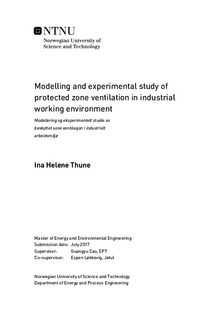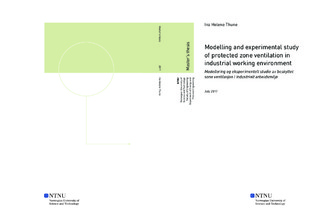| dc.description.abstract | In industrial buildings, especially melting and foundry halls, the room air is often filled with smoke and other potentially harmful particles. This is also the case at Jøtul company in Fredrikstad. An indoor climate survey concludes that the workers are dissatisfied with the indoor air quality at the workplace. The industrial environment at a working area called Greplassen at Jøtul is tested, and the environment is simulated in the laboratory at NTNU. With a local environment consisting of a hotplate, a plane jet, a laminar downward airflow and a thermal manikin, the necessary conditions to minimize the exposure to contaminants for the workers by protected occupied zone ventilation is tested experimentally. \\
The plane jet is used as an air curtain to prevent the contaminants in the upward plume from the hotplate, which simulates the hot stove pieces at Jøtul, from reaching the protected occupied zone. With a constant power supply giving a surface temperature of 170\degree C, a 'protection velocity' of 2 m/s were needed for the plane jet alone, but the tracer gas measurements showed that a velocity of 1.5 m/s also will give a protection efficiency of around 1. \\
To test the laminar downward airflow (LAF) diffuser ability to supply fresh air to the breathing zone, tracer gas measurements were conducted.
A thermal manikin were placed 25 cm underneath the LAF diffuser to create the natural plume from a person, with tracer gas supplied at the manikins feet, as well at by the hotplate. Measurements showed that for a velocity of 0.25 m/s, the tracer gas concentration actually were higher than supply concentration, making the ventilation with this velocity worse than no ventilation at all.
For an average velocity of 0.3 m/s for LAF, the tracer gas concentration decreased. Combined with the plane jet with velocity of 2 m/s, the measurement showed that fresh air is supplied to the breathing zone. This is obtained by using a total volume flow rate of 1976 m\textsuperscript{3}/h, which is well within the measured capacity of the existing ventilation system at Jøtul. \\
To prevent the air quality of becoming poorer due to a little too low LAF velocities, it is recommended to use a LAF velocity of 0.44 m/s, which gives a total airflow rate of 2822 m\textsuperscript{3}/h; 288 m\textsubscript{3}/h for the plane jet and 2534 m\textsuperscript{3}/h for the LAF diffuser of 2 m x 0.8 m. This is just within the airflow capasity of 2825 m\textsuperscript{3}/h measured at Jøtul. | en |

